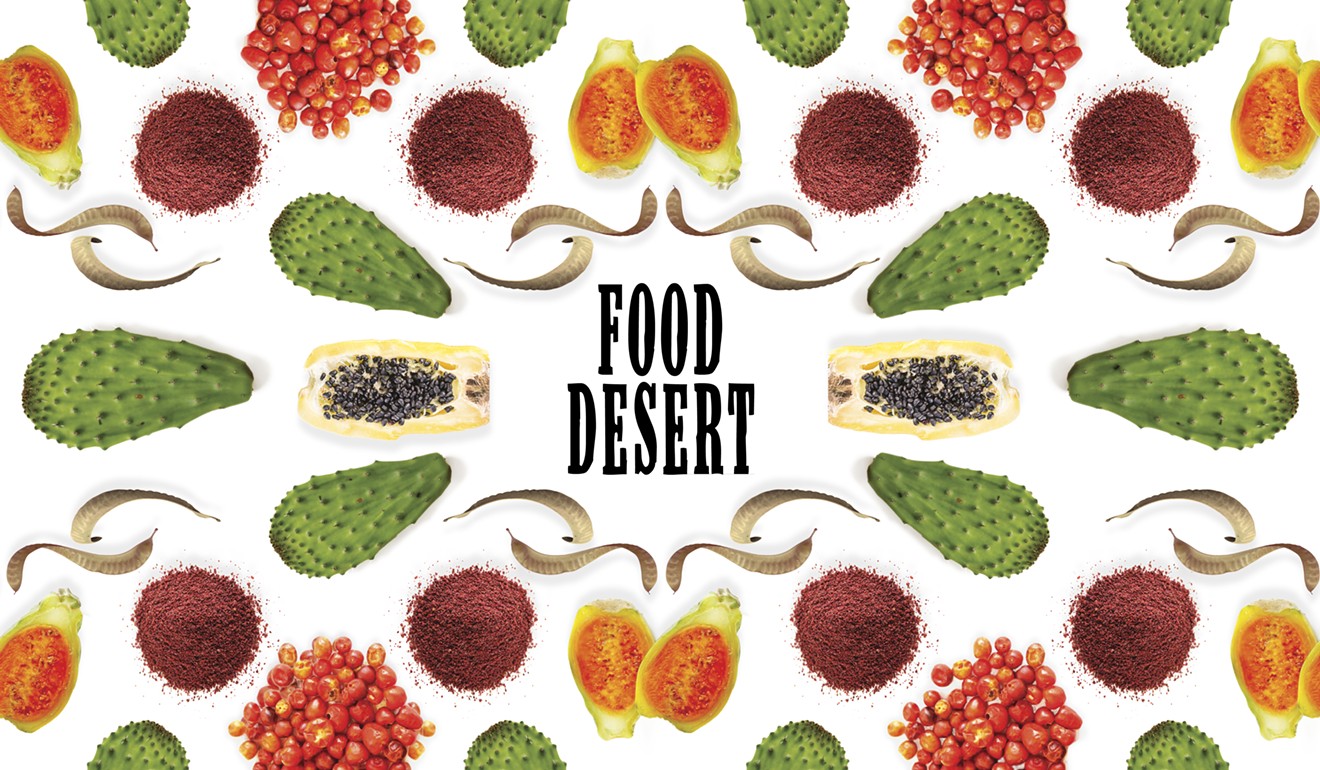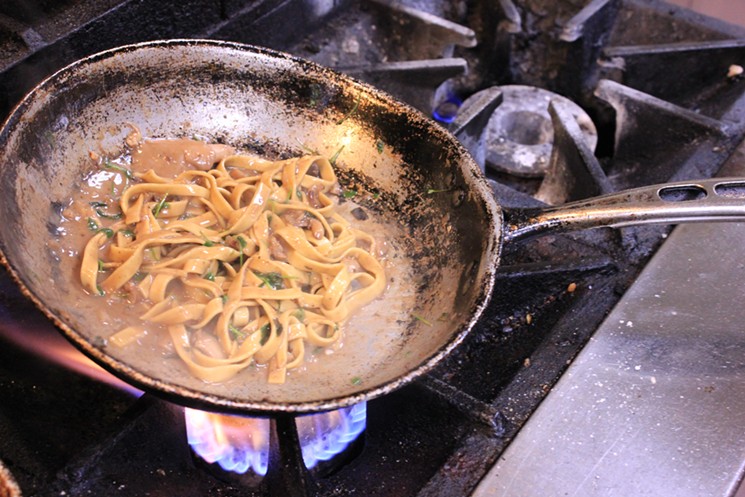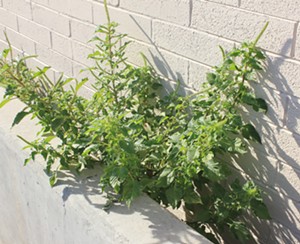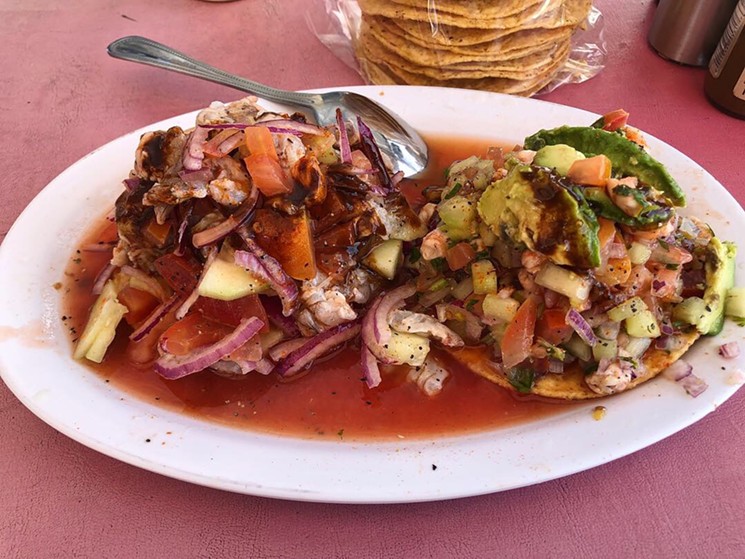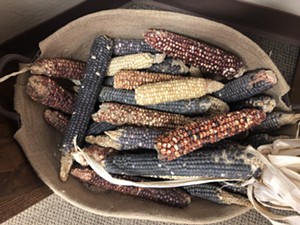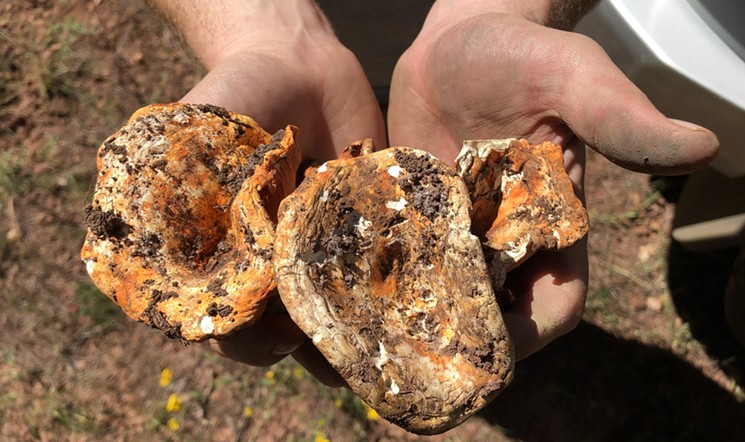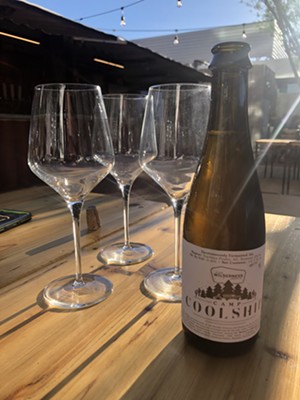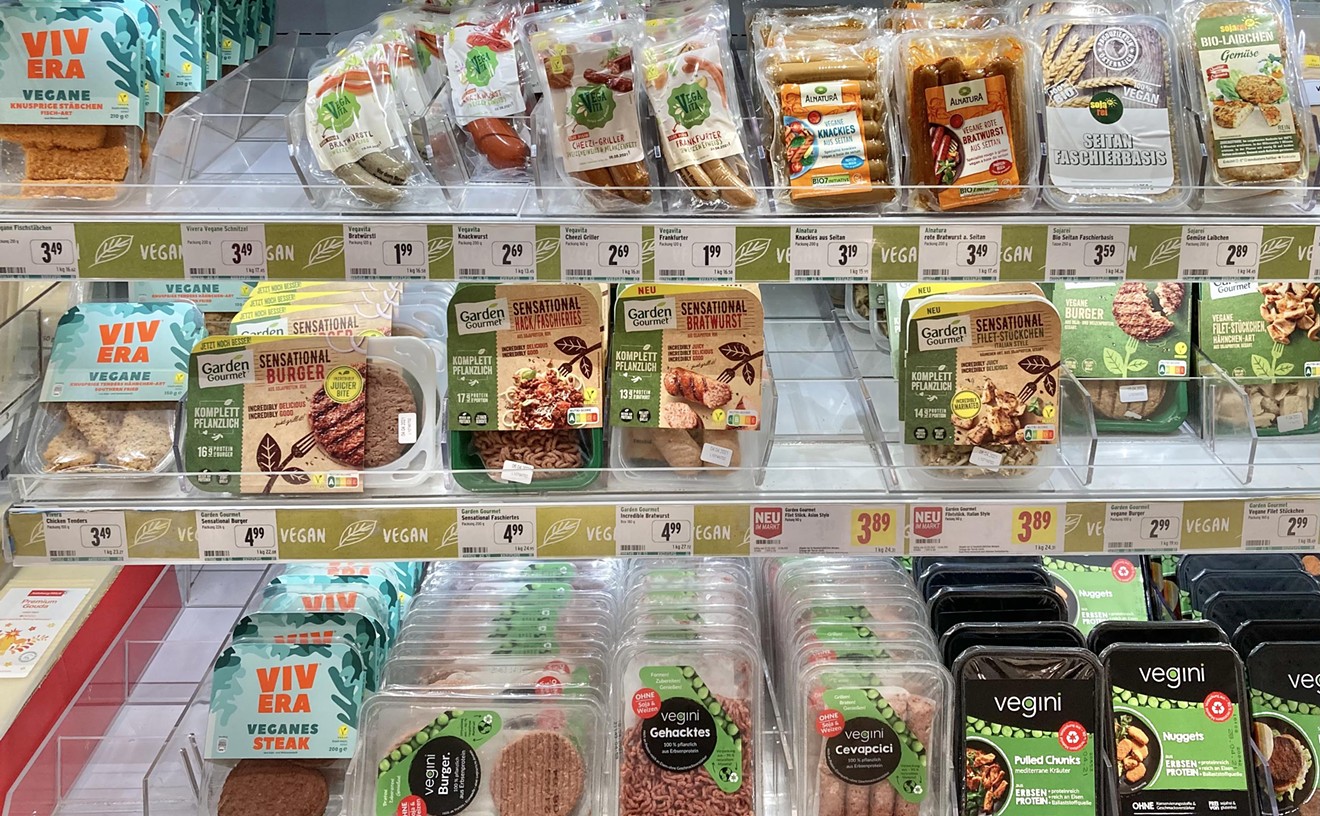What? Really? I was totally vexed.
But after living here, I know Federico was right. The American Southwest is a highly underrated region, and all of its virtues seem to intensify in our planet’s most unsung biome, the Sonoran Desert: the heat, cactuses, trees, people, sunsets, stars, mountains, thoughts, and dreams.
At once, the Sonoran seems to satisfy and smash what a desert should be. A desert is defined by rainfall — as land that gets less than 10 inches per year. The Sonoran averages seven to eight. The word “desert” conjures a wasteland, like the sliding landscape of an hourglass, the Sahara, or Tatooine. But the Sonoran is widely alive, home to more than 250 species of edible plants.
According to urban forager and botanist Mark Lewis, the number actually exceeds 1,000.
You can find the wild and farmed ancient foods of the Sonoran Desert across greater Phoenix. Places serving these ingredients tend to exist on the margins for a lot of reasons. One is that the populations with knowledge of them have been marginalized. Another is that they don’t teach you how to harvest saguaro fruit in culinary school.
Yet another is education — local diners just don’t know about these ingredients, or where to try them.
This guide to the ancient foods of the Sonoran Desert intends to remedy that.
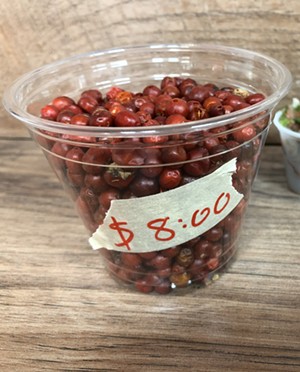
The chiltepin pepper, indigenous to the Sonoran Desert, is an incredible but underutilized ingredient.
Chris Malloy
If you believe that these foods are only being used on the outskirts, this guide might surprise you. Two of the area’s leading chefs, Charleen Badman and Chris Bianco, for example, use chiltepines. On the progressive end of this subculture, you will find the chefs of New Arizonan cuisine, marked by the creative soldering of Sonoran ingredients with global culinary ideas. Driving this movement are Cartwright’s Modern Cuisine, Cotton & Copper, and Kai Restaurant.
But these pioneers are just some of the places using these ingredients. You can also taste them at museum cafes and diners, resort restaurants and candy shops, and, crucially, at indigenous establishments like Fry Bread House or from Ramona Farms.
Some of these foods are farmed — and can be provided predictably in large quantities. Because the foraging climate shifts with the hours, days, weeks, and years, wild foods are more volatile. Some ingredients appear for just a few days a year.
“You can scout and kind of know what’s going on,” says Tamara Stanger, chef at Cotton & Copper. “You pay attention to storms and follow how plants are doing. In the springtime, you get different stuff than in the fall.” Stanger and other foragers preserve wild foods for use well beyond their seasons.
Brett Vibber, chef at Cartwright’s, captains foraging teams active for three quarters of the year. “In the Sonoran, you have your typical seasons, but you also have these bursts of growth,” he says. “Most plants are just waiting to burst into life with the smallest amount of rain and time.”
The Sonoran Desert is a harsh, sublime, fickle master.
Before we take the trail into the dust and orange blossoms, please note that this isn’t a guide to foraging. Also, this guide is partial — in both its coverage of plants and places to eat them. Even partial, even limited, I hope you find it a useful (and frequent) portal into a vast and beautiful world of food.
Acorns
We begin beyond the Sonoran, where foragers venture to escape the summer heat. In wooded parts home to trees like the Emory oak, people have long gathered acorns, also called bellotas, for stews and bread. Acorns taste cool and nutty, with something of the forest. Preparing them is a long and arduous process — partly why you only see them as specials and at events.Where to taste: Though off the menu until next year, Vibber of Cartwright’s ferments acorn miso. At Cotton & Copper, Stanger has been known to cut acorn flour into pie crust.
Amaranth
Though this pinpoint "grain" helped sustain people throughout the pre-Columbian world, we largely overlook amaranth today. We walk past amaranth in downtown Scottsdale. It rises along curbs and from cracks in alleys, growing as much as two to three inches per day. In the modern Southwest, we tend to see this plant that can produce up to 250,000 seeds only as a weed.Where to taste: Kai has baked crackers from amaranth. In south Tempe, Stanger uses the seeds to add crunch to roasted chicken and the leaves, quick to wilt, in sauces.
Cactus (Barrel)
Stout and pumpkin-shaped, barrel cactus sprouts waxy yellow fruit in early spring. These oblong fruits cluster at the top, each looking like a skinless pineapple. They taste like lemon or yuzu, but dim. Twila Cassadore, a Western Apache foods activist, likens the flavor more to squash. For centuries, the Western Apache have used barrel cactus fruit. Cassadore serves a barrel cactus salsa with desert woodrat. She uses their coal-black seeds as a wide-ranging topping. They recall black sesame seeds, partly due to their crunch.Where to taste: Try the seeds at Zak’s Chocolate in Scottsdale, where Jim and Maureen Elitzak deploy them for texture in a 70 percent cacao bar. Stanger has used the fruit in desserts like semifreddo and lemon meringue pie. If your stars align, you may find Cassadore plating woodrat at an event.
Cactus (Nopales)
Cactus pads have a deeply vegetal and lemony flavor. Sliced thin, they have a chew and pop almost like seaweed. They do well on the grill. You can often find them spineless and ready for the hot grates at farmers markets. Nopales are used on both sides of the border, and far beyond the Sonoran Desert.Where to taste: You can (and probably have) eaten nopales on a host of tacos, huaraches, and quesadillas at spots like El Tlacoyo (Tempe), Tacos Calafia (Peoria), and The Saguaro Hotel (Scottsdale). Some great unconventional uses are in a smoked chicken gumbo from Welcome Diner and a cactus-based “key lime pie” from chef Ryan Swanson at Kai.
Cactus (Prickly Pear)
You don’t have to peer into a margarita glass to find prickly pear. It is used many ways in many seasons, though its is late summer. Tasting somewhere between watermelon, strawberry, and guava, the fruit is a gateway to the desert’s bounty.Where to taste: You can taste prickly pear across the Valley: in the barbecue vinegar, meringue, and gelato at Tonto Bar & Grill in Cave Creek; in cocktails at places like LON’s Last Drop; and in beers like a Berliner weisse from Arizona Wilderness Brewing Company.
Cactus (Saguaro)
The scarlet-purple fruit of the cactus that marks the bounds of the Sonoran is called the “truffle of the desert.” Saguaro fruit flashes into brief season in June and July. Gatherers use poles to jostle meaty pods down from as high as 40 feet. Saguaro fruit’s flavor veers into the same dark-fruit zone as red plum and cranberry. Restaurants lucky to get saguaro fruit freeze, dehydrate, or jam what they can, protracting the ephemeral season. Saguaro blossoms can also be cooked into long-lasting syrup.Where to taste: Kai Restaurant flavors bison with saguaro syrup. The fruit appears on the Cartwright’s Arizona omakase, a winding tasting menu through the desert and forests. Two summers ago, Brett Vibber sluiced violet saguaro jam under venison tartare. This past summer, he improvised with saguaro fruit vinegar.
Chiltepin
The tiny, ball-shaped chiltepin leads with an elusive flash of fruit before thunderous heat. This pepper, one of the truly great Sonoran foods, is the only chile native to the United States. Whether wild or gardened, chiltepines come into season in late summer and fall. They can be used green or red, fresh or dried.Where to taste: Chiltepin laces food at Sonoran Mexican restaurants and trucks across the Valley, including in the phenomenal aguachile from Tacos y Mariscos El Sinaloa on 16th Street. Phoenix City Grille uses chiltepines in a vinaigrette. Bianco has used the chiltepin in arrabiata sauce at Pane Bianco Van Buren. The king of the chiltepin, Rene Andrade of Ghost Ranch and Tempe Public Market Café, uses them in in both sweet and savory dishes, such as ceviche and brownies.
Corn
Maize has been a fixture in these parts since before more than 700 miles of Hohokam canals diverted water from the Salt and Gila rivers, flooding cornfields. Today, on the Gila River Indian Community, Ramona Farms grows heritage blue, pink, red, and 60-day Pima corn, roasted in the picking fields, sold simply shelled or shaped into the likes of polenta, grits, pinole, and ga’ivsa. In Navajo and Apache culinary traditions, newly harvested corn is slowly cooked underground. Of course, you can also find fresh corn as masa, shaped into tortillas, gorditas, sopes, huaraches, and other amazing vehicles.Where to taste: Corn is everywhere. For a taste of indigenous varieties, look to the Ramona Farms online store, where you can order some for your kitchen. Kai uses Ramona corn in pozole, souffle, and pie crust. Stanger has used it to bread fried chicken. Look for Ramona corn as grits at Phoenix City Grille or even at Welcome Diner, under a heap of smoked chicken and pickled onion.
Mesquite
The ribbed, rattling pods of the mesquite tree have been used for sustenance since the pre-Columbian days of the Hohokam, who pounded mesquite beans into bread flour. Today, the abundant seeds are generally harvested before the June and July monsoons, though they often linger beyond. Beans are hammer-milled into flour (sweet and dusky) or cooked into syrup (like dark honey pulled through a desert filter). For your own culinary needs, you can order mesquite syrup from Cotton Country Jams in south Phoenix or flour from San Xavier Co-op in Tucson.Where to taste: Azukar Coffee in south Phoenix blends a latte from mesquite syrup. Tamara Stanger brushes chicken with syrup she simmers from her own foraged beans and citrus. Cartwright’s has cut mesquite flour with grain flour to make pasta and gnocchi. Café Allegro bakes a sourdough focaccia with mesquite. And at Super Chunk Sweets & Treats, a mesquite-flour chocolate chip cookie has entered local pastry legend.
Mushrooms
Wild mushrooms don’t really grow in the desert, but they thrive just beyond. Come late summer, when the desert foraging season is hot and still, chanterelles, morels, russulas, and lobster mushrooms appear in the forests of Prescott, Payson, and Flagstaff — and on better metro Phoenix menus.Where to taste: Mushrooms trickle to a wide range of restaurants. Sasha Raj of 24 Carrots gathers fungi herself, and uses them to deepen soup stocks, gravies, and even a bean curd cheesesteak.
Palo Verde
The green-barked state tree of Arizona is practically an arboreal grocery store in itself. The beans, shoots, berries, and yellow flowers can be eaten. The beans, often called “desert edamame,” are the most commonly eaten of the quartet. Like mesquite beans, they come sheathed in long pods.Where to taste: After rain, Vibber of Cartwright’s snips the shoots that sprout from the tree, opting to use them like microgreens. He pickles the berries and substitutes them for capers. Downtown at The Breadfruit, Danielle Leoni recently has started to use the beans in her jerk sauce. She will be incorporating them in an Arizona-centric bean dish come fall’s new menu.
Squash
One of the three ancient sisters together with corn and beans, squash has a history of cultivation along the Salt and Gila rivers. That said, heirloom squash varietals like the Magdalena Big Cheese are tragically rare in the Valley. Luckily, even common squash can give you a taste of the past.Where to taste: Fry Bread House wraps a melting squash burro that can be ordered on c’emet, an O’odham tortilla. The Heard Courtyard Café bowls the three sisters as a chilled soup. A strong dark horse option can be found at Tacos Chiwas: a warm calabacitas taco with asadero cheese, the most underrated taco on the menu.
Sumac
Though most often associated with Middle Eastern food, wild sumac species grow in the Sonoran Desert. Usually, once gathered, sumac berries are ground into fine powder and used as a spice. Sumac brings a bright lemony burst related to citrus, but on a bit of a different wavelength minus the acid.Where to taste: Jaren Bates, sous chef at Cartwright’s, has crusted tuna with sumac and combined the berry with juniper into a sauce, pulling on his Navajo traditions. On top of pairing sumac with piloncillo to sweeten bison and with cranberry to jolt venison, Swanson of Kai has also used sumac in desserts.
Tepary Beans
When planted to align with the summer rains, tepary beans require minimal watering. Ramona Farms is the chief purveyor of tepary beans in metro Phoenix. Ramona and Terry Button grow three kinds: white, brown, and black. Their daughter, Velvet Button, says that when brown beans are cooking, they smell like desert rain.Where to taste: These beans have carved out some impressive real estate, but still have a ways to go. Charleen Badman of FnB in Scottsdale plates tepary beans with lamb loin. Phoenix City Grille uses them in a “superfoods” salad. You can also find them in the veggie burger at Café Allegro, or in hummus with frybread at the Heard Courtyard Café.
Wolfberry
Botanist Mark Lewis estimates that 22 species of wolfberry grow in the Southwest. They thrive in the Sonoran, where bushes that can rise to the height of a person thrive on little water. They are rare to find at restaurants. You may find them integrated into specials and one-off dinners, if you keep your eyes open.Where to taste: Stanger is an exponent of the wolfberry. She has served wolfberry jam with venison sausage. Ryan Swanson of Kai has deployed them in sauces, vinaigrettes, and fruit leathers. If you want a more readily available taste, seek goji berries, which are a kind of wolfberry.
Yeast and Microbes
These catalysts of fermentation are specific to time and place. Wild yeast can be used to make bread, booze, and more. When collected in any given part of the desert, they will, in ways impossible to precisely gauge, reflect that particular part of the desert.Where to taste: Arizona Wilderness Brewing Company employs spontaneous fermentations — using wild yeasts to craft beer. The brewery’s coolship project is a series of special-release beers that are fermented overnight in the state’s wild reaches. Additionally, Town Under Black, a Tucson distillery, has plans to use desert-gathered yeasts to make distilled spirits. Also, though not an intoxicating potable, all the bread at Cartwright’s is now made using wild yeast culled from sumac berries.

